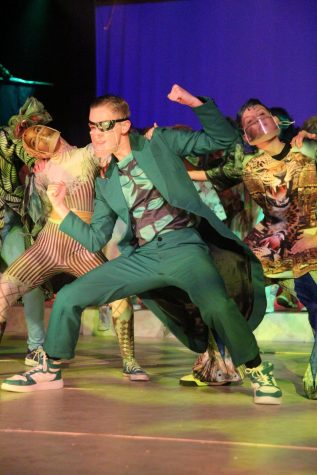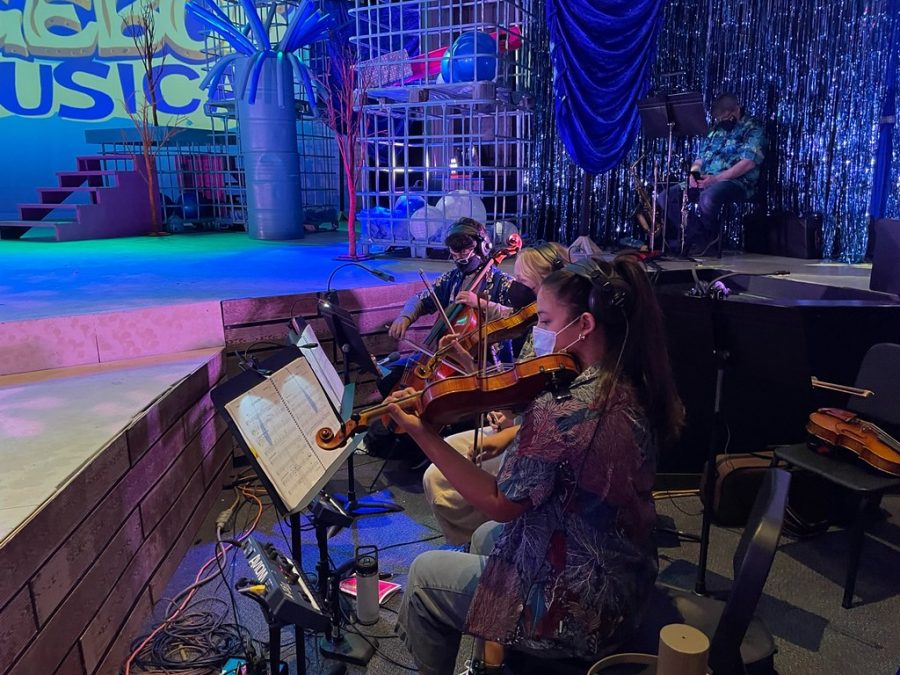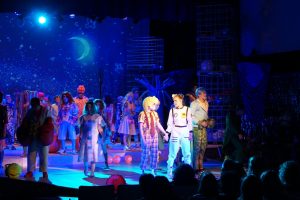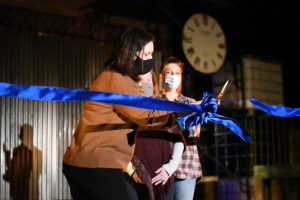Can’t have a hit without a pit
Combining fine arts disciplines, orchestra students, professional musicians perform “SpongeBob Musical” score
Seniors Julian Casas, Ileana Nicholson and Lucy Hamre rehearse their music before a performance of The SpongeBob Musical. Casas, Nicholson and Hamre are three members of the pit orchestra for the show that helps provide an added layer of magic to the performance.
September 24, 2021
The live performance of MacTheatre’s The SpongeBob Musical may seem smooth and effortless, but the stage experience is the result of hundreds of hours of hard work and collaboration from the combined talents of the Fine Arts Academy.
This fall’s production of The SpongeBob Musical features McCallum’s award-winning live pit orchestra for the first time in two years, though it looks a little different than it has in the past.
Five McCallum students make up the orchestra part of the pit, but professionals have been hired to perform as the band.
The Pit’s population
The student members of the pit orchestra, seniors Ileana Nicholson, Lucy Hamre, Milo Darlington, Julian Casas and Calder Carey were selected by orchestra director Ricky Pringle to represent the school in this professional setting. With only three rehearsals to learn and rehearse the score before combining with the cast, the members of the pit have gotten a taste of what it would be like to work as professional musicians.
“It’s a little bit nerve-wracking, but I’m excited to play with professionals since I’m planning on doing this professionally,” first violinist Ileana Nicholson said before the first rehearsal. “I feel lucky to be able to have this opportunity to play in the pit before I’m thrown into the professional world.”
Second violinist Lucy Hamre, who has been a member of the pit orchestra before, believes that pit members are getting a unique experience this time around. Playing with professionals rather than student band members, especially in the absence of a true conductor, requires a lot of responsibility on the students’ part.
“It’s really nice to know that people trust me to handle such a big part of a show,” Hamre said. “Something to get used to has been finding this new sense of confidence and thinking like, you know how to do this and trusting that everyone has their parts down.”
Nicholson believes that playing in the pit requires a lot of independence and leadership. Playing music that differs from what is typically played in an orchestra and being placed in such an unfamiliar environment has allowed her to bond with the other student pit members and to see them as stronger, more versatile musicians.
“I’ve been playing with the people in the pit since freshman year, so we’re able to read each other pretty well and we play in a quartet together outside of school,” she said. “I think the fact that we have a personal connection will help with the lack of a conductor. It feels like a comfortable environment but also, we have to be on top of it because there are professionals involved and we want to make the show as good as we can.”
The Bikini Bottom sound
The score for The SpongeBob Musical requires a completely different skill set than typical orchestral music. The music is written in keys that string players don’t normally play in and is stylistically diverse, containing everything from fiddle-style banjo parts to soulful and mysterious melodies, all requiring different technical skills. Written into the music are silly reminders of how certain sections are supposed to sound, including “Concerto in Evil.”
The music also contains difficult rhythms and tempo changes that differ from typical classical repertoire. Nicholson’s first violin part includes some flourishes for effect, fast notes and scales and sad violin melodies, though it also requires a lot of counting.
In an effort to transport the audience to Bikini Bottom, Nicholson has made sure to adjust her playing to suit the feel of different parts of the show.
“I think the orchestra adds some underlying character that you wouldn’t get with just a piano track,” she said. “Strings add a different character just like the guitar or bass guitar or percussion will.”
Stringed instruments are able to produce some effects that band instruments cannot. Some of these effects, having to do with the versatility that comes from using a bow and plucking strings, help establish the silly, oceanic feeling of SpongeBob.

“There’s one moment in a jellyfish song where we get to slide around the violin and I just try to picture the jellyfish in ‘SpongeBob,’” Nicholson said. “I think all of us kind of grew up watching SpongeBob, so it’s a visual experience for sure. Having that visual in mind and being raised on the show helped me to understand the music and what the composer was asking for.”
Members of the pit also experimented with getting in character, just as the actors do, in order to capture the right feel for the music. With this in mind, Nicholson has been listening to YouTube versions of the musical.
“It’s all very lighthearted, and it’s important not to take it too seriously because it will translate into the music, and it won’t sound as happy and SpongeBob-like,” Nicholson said.
Hamre stated that she was also “definitely going to try to embody that ocean behavior.”
Communication is key to the members of the pit as they play the whole musical from start to finish, including in applause segues and for effects. Nicholson stated that they have to “read each other’s minds in a sense” to get a feel for what the actors want.
For official changes, the actors communicate to Mr. Mabry, SpongeBob’s musical director, and he alerts the pit. Additionally, the members of the pit were given special headphones with personal volume controls that they use to hear the vocalists and each other, allowing them to stay together easily without a conductor.
Aside from the pressure that comes with it, the members of the pit have made their fair share of memories. SpongeBob the Musical is unique in that the pit is very much a part of the production. At one point in the show, SpongeBob asks the pit for a ukulele, and in another, Squidward asks the pit questions to which they respond with silly sound effects.
Hamre said that the production involves a lot of things falling from the sky such as bubbles and confetti, and that the pit had a “near yoga ball hitting experience.” The pit now has yoga balls written into their parts.
The benefits of the pit
Senior Jessie Lucas, who plays SpongeBob, believes that having a live pit orchestra is an enriching experience for the audience as well as herself.
“Having a pit makes it a lot more genuine,” Lucas said. “Recordings are a lot harder to manipulate with the actors’ voices. It’s cool as an audience member to hear all the music being played right in front of you and to hear it sync up with the actors.”
As an actor and singer, they find that the pit helps her get in the mode of the genre she’s singing and that it is great for making changes like shifting keys. Overall, having a live pit gives actors more freedom and allows them to get in character more easily.
“SpongeBob is a male role, and I’m a girl, so I had to change it up a little so I could sing it,” Lucas said. “Having a live orchestra was so much easier for that. The orchestra is so versatile and they pick up changes quickly.”
As a singer, Lucas also had to use a lot of different styles, as the musical includes many genres and every song was written by a different composer. While the musical has a cohesive sound, it uses effects and synthesizers to fit with the goofy tone ‘SpongeBob’ takes on. Additionally, she believes that working with the pit and the crossing of the fine arts disciplines to produce the musical has given them new respect for other art forms.
“It feels empowering to play with the orchestra because it’s all of us making this glorious sound together,” Lucas said. “I think it showcases the technical aspects of theater, the musical elements of theater, and the acting elements of theater and the show brings it all together.”
Nicholson believes having a live pit benefits the actors because it makes the show more personal and authentic. It also helps to establish the environment of the show.
“The hope is that the performers will be able to connect to the music more because we are real people in the pit, not just a backtrack,” she said. “We’re bouncing off of them and they’re bouncing off of us and they can kind of personalize the show more and we can personalize it to them.”
Having a live pit also benefits the audience.
“I remember I would go to McCallum shows and sometimes just forget that the pit was there,” Nicholson said. “I feel like you’re thrown into the show more when there’s a live pit.”
Now as a member of the pit, she views her role similarly. While the pit is an integral part of any McCallum musical, she believes the importance of the pit’s role is to complement the musical theater actors and to show the audience all the hard work they’ve done.
Both Nicholson and Hamre believe that it’s exciting for the McCallum orchestra to get this moment to shine.
“I like to just sit and listen and watch the music theater kids get at it,” Hamre said. It’s so crazy to see all of this come together and to be a part of that.”






